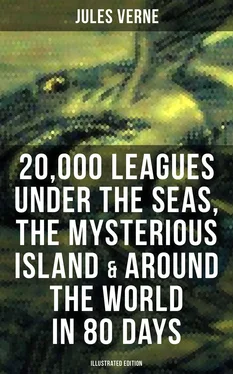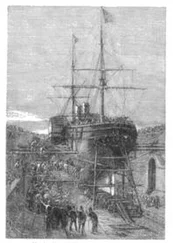After our position fix, the Nautilus’s latitude bearings were modulated to the southwest. Our prow pointed to the Indian Ocean. Where would Captain Nemo’s fancies take us? Would he head up to the shores of Asia? Would he pull nearer to the beaches of Europe? Unlikely choices for a man who avoided populated areas! So would he go down south? Would he double the Cape of Good Hope, then Cape Horn, and push on to the Antarctic pole? Finally, would he return to the seas of the Pacific, where his Nautilus could navigate freely and easily? Time would tell.
After cruising along the Cartier, Hibernia, Seringapatam, and Scott reefs, the solid element’s last exertions against the liquid element, we were beyond all sight of shore by January 14. The Nautilus slowed down in an odd manner, and very unpredictable in its ways, it sometimes swam in the midst of the waters, sometimes drifted on their surface.
During this phase of our voyage, Captain Nemo conducted interesting experiments on the different temperatures in various strata of the sea. Under ordinary conditions, such readings are obtained using some pretty complicated instruments whose findings are dubious to say the least, whether they’re thermometric sounding lines, whose glass often shatters under the water’s pressure, or those devices based on the varying resistance of metals to electric currents. The results so obtained can’t be adequately double-checked. By contrast, Captain Nemo would seek the sea’s temperature by going himself into its depths, and when he placed his thermometer in contact with the various layers of liquid, he found the sought-for degree immediately and with certainty.
And so, by loading up its ballast tanks, or by sinking obliquely with its slanting fins, the Nautilus successively reached depths of 3,000, 4,000, 5,000, 7,000, 9,000, and 10,000 meters, and the ultimate conclusion from these experiments was that, in all latitudes, the sea had a permanent temperature of 4.5 degrees centigrade at a depth of 1,000 meters.
I watched these experiments with the most intense fascination. Captain Nemo brought a real passion to them. I often wondered why he took these observations. Were they for the benefit of his fellow man? It was unlikely, because sooner or later his work would perish with him in some unknown sea! Unless he intended the results of his experiments for me. But that meant this strange voyage of mine would come to an end, and no such end was in sight.
Be that as it may, Captain Nemo also introduced me to the different data he had obtained on the relative densities of the water in our globe’s chief seas. From this news I derived some personal enlightenment having nothing to do with science.
It happened the morning of January 15. The captain, with whom I was strolling on the platform, asked me if I knew how salt water differs in density from sea to sea. I said no, adding that there was a lack of rigorous scientific observations on this subject.
“I’ve taken such observations,” he told me, “and I can vouch for their reliability.”
“Fine,” I replied, “but the Nautilus lives in a separate world, and the secrets of its scientists don’t make their way ashore.”
“You’re right, professor,” he told me after a few moments of silence. “This is a separate world. It’s as alien to the earth as the planets accompanying our globe around the sun, and we’ll never become familiar with the work of scientists on Saturn or Jupiter. But since fate has linked our two lives, I can reveal the results of my observations to you.”
“I’m all attention, captain.”
“You’re aware, professor, that salt water is denser than fresh water, but this density isn’t uniform. In essence, if I represent the density of fresh water by 1.000, then I find 1.028 for the waters of the Atlantic, 1.026 for the waters of the Pacific, 1.030 for the waters of the Mediterranean—”
Aha, I thought, so he ventures into the Mediterranean?
“—1.018 for the waters of the Ionian Sea, and 1.029 for the waters of the Adriatic.”
Assuredly, the Nautilus didn’t avoid the heavily traveled seas of Europe, and from this insight I concluded that the ship would take us back—perhaps very soon—to more civilized shores. I expected Ned Land to greet this news with unfeigned satisfaction.
For several days our work hours were spent in all sorts of experiments, on the degree of salinity in waters of different depths, or on their electric properties, coloration, and transparency, and in every instance Captain Nemo displayed an ingenuity equaled only by his graciousness toward me. Then I saw no more of him for some days and again lived on board in seclusion.
On January 16 the Nautilus seemed to have fallen asleep just a few meters beneath the surface of the water. Its electric equipment had been turned off, and the motionless propeller let it ride with the waves. I assumed that the crew were busy with interior repairs, required by the engine’s strenuous mechanical action.
My companions and I then witnessed an unusual sight. The panels in the lounge were open, and since the Nautilus’s beacon was off, a hazy darkness reigned in the midst of the waters. Covered with heavy clouds, the stormy sky gave only the faintest light to the ocean’s upper strata.
I was observing the state of the sea under these conditions, and even the largest fish were nothing more than ill-defined shadows, when the Nautilus was suddenly transferred into broad daylight. At first I thought the beacon had gone back on and was casting its electric light into the liquid mass. I was mistaken, and after a hasty examination I discovered my error.
The Nautilus had drifted into the midst of some phosphorescent strata, which, in this darkness, came off as positively dazzling. This effect was caused by myriads of tiny, luminous animals whose brightness increased when they glided over the metal hull of our submersible. In the midst of these luminous sheets of water, I then glimpsed flashes of light, like those seen inside a blazing furnace from streams of molten lead or from masses of metal brought to a white heat—flashes so intense that certain areas of the light became shadows by comparison, in a fiery setting from which every shadow should seemingly have been banished. No, this was no longer the calm emission of our usual lighting! This light throbbed with unprecedented vigor and activity! You sensed that it was alive!
In essence, it was a cluster of countless open-sea infusoria, of noctiluca an eighth of an inch wide, actual globules of transparent jelly equipped with a threadlike tentacle, up to 25,000 of which have been counted in thirty cubic centimeters of water. And the power of their light was increased by those glimmers unique to medusas, starfish, common jellyfish, angel-wing clams, and other phosphorescent zoophytes, which were saturated with grease from organic matter decomposed by the sea, and perhaps with mucus secreted by fish.
For several hours the Nautilus drifted in this brilliant tide, and our wonderment grew when we saw huge marine animals cavorting in it, like the fire-dwelling salamanders of myth. In the midst of these flames that didn’t burn, I could see swift, elegant porpoises, the tireless pranksters of the seas, and sailfish three meters long, those shrewd heralds of hurricanes, whose fearsome broadswords sometimes banged against the lounge window. Then smaller fish appeared: miscellaneous triggerfish, leather jacks, unicornfish, and a hundred others that left stripes on this luminous atmosphere in their course.
Some magic lay behind this dazzling sight! Perhaps some atmospheric condition had intensified this phenomenon? Perhaps a storm had been unleashed on the surface of the waves? But only a few meters down, the Nautilus felt no tempest’s fury, and the ship rocked peacefully in the midst of the calm waters.
Читать дальше












